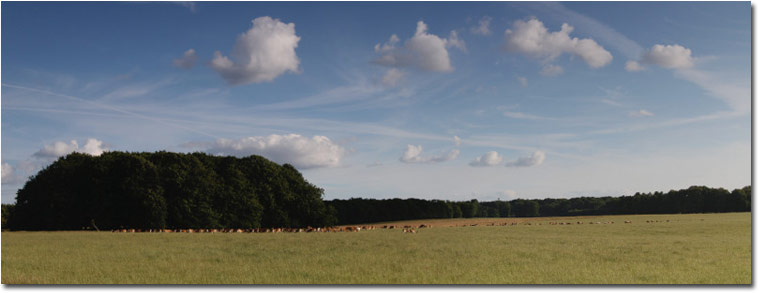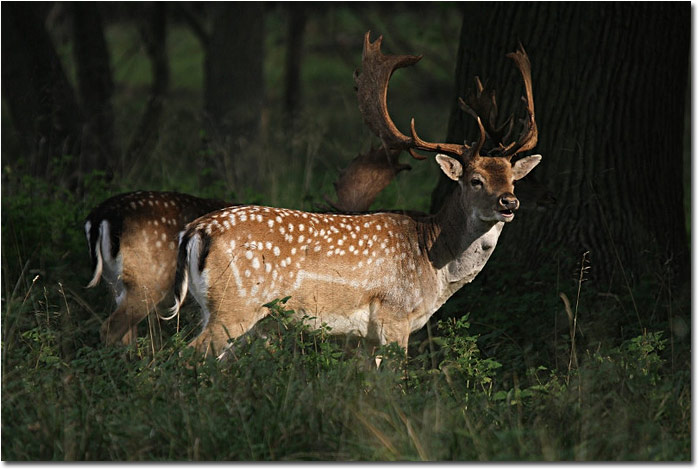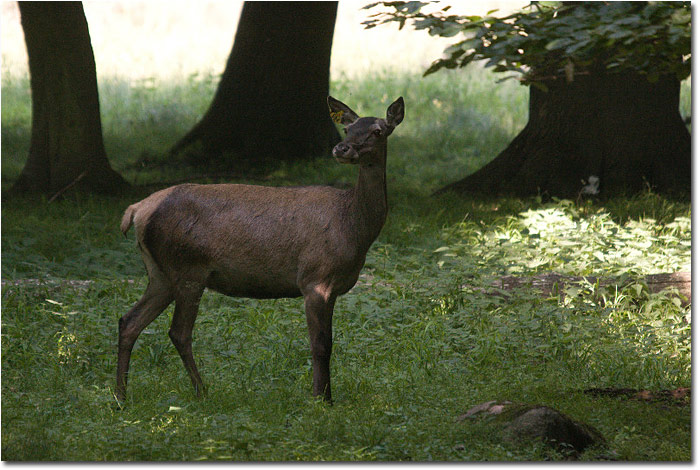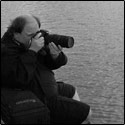|
|
Dyrehaven (in English generally referred to as 'The Deer Park') is an 11 square kilometer nature reserve to the north of Copenhagen, with a history dating back more than 300 years. The Deer Park was originally created as a private hunting ground for King Frederik III in 1669, when deer were herded into the area and then fenced in. In 1756, the park was opened to the public and it is now used for many outdoor activities.

The park hosts various species of animals as well as different kinds of terrain. However, as the name suggests, the greatest attraction is the deer. At any given time there are about 2000 deer in the park, consisting roughly of 300 Red Deer, 1700 Fallow Deer, and 100 Sika Deer.
Red Deer - these are almost two meters tall and can weigh up to 240kg. They are found throughout Europe, parts of Asia, and in northern Africa. The males have impressive antlers, nearly a meter in length; they grow at a rate of up to 2.5cm/day and are shed yearly.

Fallow Deer - this is a smaller kind of deer. The males are up to 125cm tall and weigh up to 100kg. The adults have characteristic broad flat antlers with small finger-like protruding spines. They can run at speeds of up to 45 km/h and jump up to 5 meters.

Sika Deer - these deer where introduced in Europe from Japan in the 19th century; they reach 120cm in height and weigh up to 70kg. Unlike other deer, the Sika keep their characteristic white spots into adulthood. To attract mates during the mating season, they make loud whistling calls that are heard up to 1km away.

The deer in the park are less wary of humans than most wild deer, but you should still always keep a respectable distance to prevent stressing the animals or any accidents. In an effort to keep the deer “wild” and to prevent any unfortunate close confrontations between the visitors and the wildlife, the park officials forbid feeding of the deer and will put down any animal that has lost its fear of humans.
Other Animals
The other mammals in the park are mainly nocturnal. The foxes, rabbits, stoats, and badgers are never seen by most of the parks visitors. The best chance of photographing them is at dusk or dawn, but this will require a camouflaged tent or a hide made of natural materials.

There are also over 100 species of bird that have been spotted in the park. Birds such as swans, geese, and ducks are relatively commonplace, but in rare cases one may see birds of prey such as ospreys, kestrels, hawks, and eagles.
Equipment to Bring
You should have a zoom lens of at least 300mm for photographing the deer. This will ensure that you can get full frame shots of single deer. A shorter lens may bring you too close to the subjects “comfort zone” and the deer will leave.
As one shouldn't disturb the deer during their mating season or if they have young, the avid nature photographers are often seen with 1200mm lenses. This allows for very close-up shots without disturbing the animals.
For bird photography, you will also require a long zoom lens. A pair of good binoculars is similarly useful.
Different Times of Year
From May to June is the calving season for the deer, and about 700 are born each year. The calves are usually hiding in the tall grass until they are old enough to follow the herd.
September to October is the mating, or rutting, season for the Red Deer. The males will fight to create their own territory and gather their flock of mates.
October to November is the mating season for the Fallow Deer; the males form a flock where each deer has its own small territory. The females will approach the flock and choose their mate.
The Terrain
The park’s terrain has a lot of variation; there are large open areas, thick forest, and both flat and hilly areas. The park has areas with water, including lakes, rivers, and marshes. This variation in the terrain provides an ideal habitat for a wide range of animals.
The following areas are the best locations for photographing wildlife:
Eremitagesletten is a large open area, originally used as a hunting ground by Danish royalty. There are usually several hundred deer spread over this area. This is the best place to watch the mating rituals of the deer. This area is also ideal for landscape photography and to take photos of the birds of prey as they hunt.
Mølleåen is a river that flows through the north part of the park where one can find a rich variety of birds. In this area, one can see the kingfisher and herons hunting for fish. This forested area is the ideal place to set up one’s hide to capture the animals which hunt by the river, as-well as the nocturnal animals which come to the river to drink.
|
 Simon James was born in Sterling in Scotland but has lived in Denmark most of his life. He took up photography in 1998 when he became interested in nature photography. Since then, Simon has shot photos of products in a studio, at events such as weddings, and for a number of websites and companies. Today he helps run the site www.eminentphoto.com, which offers photo prints, free images, and photo articles, mainly within nature and wildlife photography.
Simon James was born in Sterling in Scotland but has lived in Denmark most of his life. He took up photography in 1998 when he became interested in nature photography. Since then, Simon has shot photos of products in a studio, at events such as weddings, and for a number of websites and companies. Today he helps run the site www.eminentphoto.com, which offers photo prints, free images, and photo articles, mainly within nature and wildlife photography.